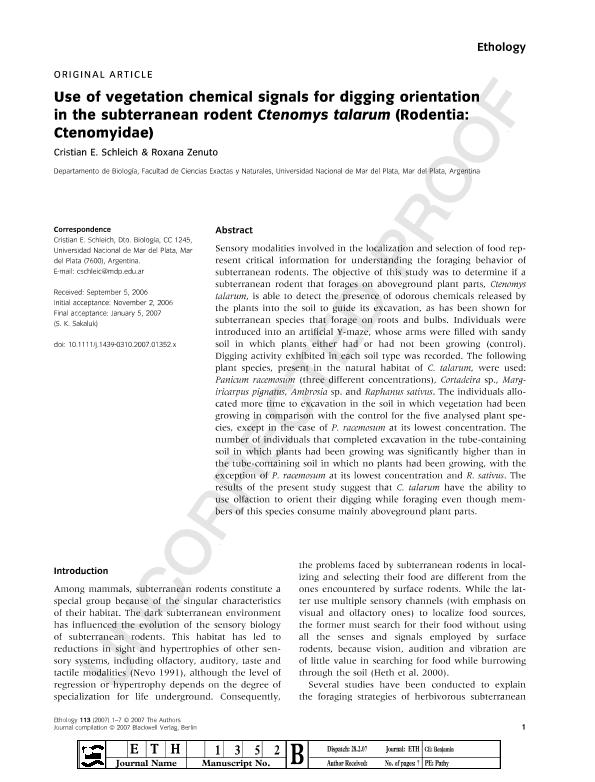Artículo
Use of vegetation chemical signals for digging orientation in the subterranean rodent Ctenomys talarum (Rodentia: Ctenomyidae)
Fecha de publicación:
06/2007
Editorial:
Wiley Blackwell Publishing, Inc
Revista:
Ethology
ISSN:
0179-1613
Idioma:
Inglés
Tipo de recurso:
Artículo publicado
Clasificación temática:
Resumen
Sensory modalities involved in the localization and selection of food represent critical information for understanding the foraging behavior of subterranean rodents. The objective of this study was to determine if a subterranean rodent that forages on aboveground plant parts, Ctenomys talarum, is able to detect the presence of odorous chemicals released by the plants into the soil to guide its excavation, as has been shown for subterranean species that forage on roots and bulbs. Individuals were introduced into an artificial Y‐maze, whose arms were filled with sandy soil in which plants either had or had not been growing (control). Digging activity exhibited in each soil type was recorded. The following plant species, present in the natural habitat of C. talarum, were used: Panicum racemosum (three different concentrations), Cortadeira sp., Margiricarpus pignatus, Ambrosia sp. and Raphanus sativus. The individuals allocated more time to excavation in the soil in which vegetation had been growing in comparison with the control for the five analysed plant species, except in the case of P. racemosum at its lowest concentration. The number of individuals that completed excavation in the tube‐containing soil in which plants had been growing was significantly higher than in the tube‐containing soil in which no plants had been growing, with the exception of P. racemosum at its lowest concentration and R. sativus. The results of the present study suggest that C. talarum have the ability to use olfaction to orient their digging while foraging even though members of this species consume mainly aboveground plant parts.
Archivos asociados
Licencia
Identificadores
Colecciones
Articulos(IIMYC)
Articulos de INSTITUTO DE INVESTIGACIONES MARINAS Y COSTERAS
Articulos de INSTITUTO DE INVESTIGACIONES MARINAS Y COSTERAS
Citación
Schleich, Cristian; Zenuto, Roxana Rita; Use of vegetation chemical signals for digging orientation in the subterranean rodent Ctenomys talarum (Rodentia: Ctenomyidae); Wiley Blackwell Publishing, Inc; Ethology; 113; 6; 6-2007; 573-578
Compartir
Altmétricas




